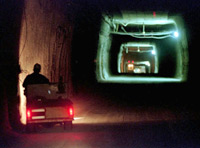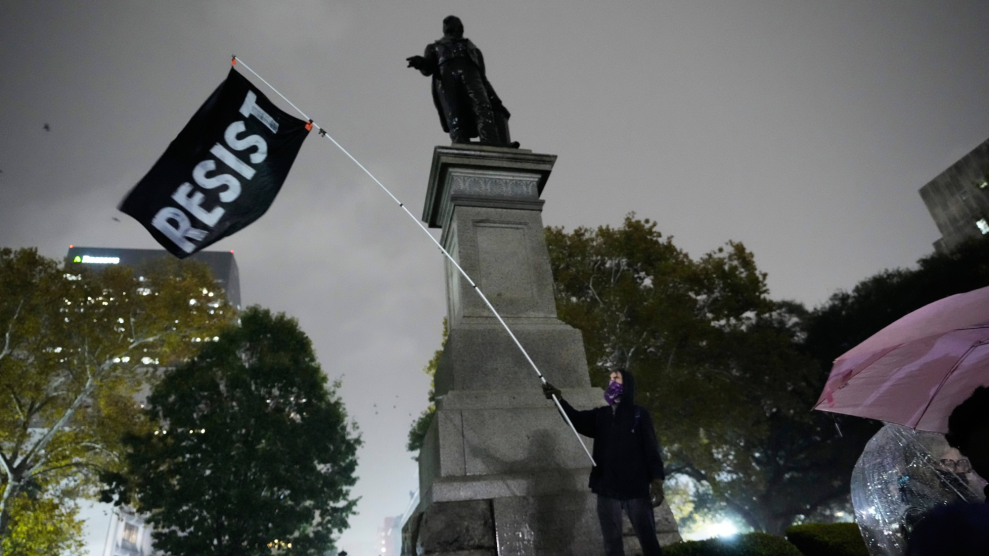
Photo: Associated Press/Wide World Photos
Carlsbad, New Mexico, was ready the day Department of Energy (DOE) officials came to town in the fall of 2002. All along the city’s main drag, American flags fluttered in the desert breeze to mark the occasion. Mayor Bob Forrest and other civic leaders were on hand to extend a warm welcome—and to make the case that Carlsbad, already home to the nation’s largest underground nuclear-waste dump, should also host the Bush administration’s new nuclear-bomb-making plant. “The United States needs this facility. Carlsbad wants it,” the city’s development officer Lorraine Allen told an enthusiastic audience at a public meeting last June. “It’s a perfect match.”
For Carlsbad and other towns vying for the plant, the lure, pure and simple, is jobs. The Bush administration plans to spend as much as $4 billion to build the proposed “modern pit facility,” which would produce plutonium “pits,” the hollow grapefruit-size spheres of plutonium that trigger fusion reactions in thermonuclear bombs. This spring, the DOE plans to pick a site from a short list of five candidates, including Carlsbad; Amarillo, Texas; and North Augusta, South Carolina, home to the Savannah River weapons complex.
Outside those towns, the administration’s plans for the new pit facility aren’t going over quite as well. Critics contend the proposed plant—one of the largest additions to the U.S. nuclear-weapons complex in 40 years—would mark a radical shift in U.S. nuclear-arms policy, and even inspire a whole new arms race, by putting the United States in the business of building tactical, or “usable,” mininukes.
Indeed, the DOE says the new facility is needed not just to make replacement pits for existing weapons, but to provide the “flexibility to produce pits of a new design in a timely manner.” To some observers, that actually means the ability to make pits for nuclear weapons that can be fired in battle—such as deep-penetrating “bunker busters” that can destroy underground command centers. “In order to have mininukes, you need to mass-produce them, and the United States does not currently have the capacity to do this,” says Robert Alvarez, a former top DOE policy adviser in the Clinton administration. “The modern pit facility is part of a bigger effort [to reconstitute] the nuclear production and testing complex.”
There’s no question that the Bush administration has been taking U.S. nuclear policy in a fundamentally different direction. In a report to Congress two years ago, the Pentagon called for a “revitalized nuclear weapons complex” that would be less bound by nonproliferation and nuclear test-ban treaties and more focused on the “agility” and “flexibility” needed to meet current U.S. security threats. The report, among other things, argues for speedier scheduling of underground nuclear tests and states that tactical nuclear weapons “might provide important advantages for enhancing the nation’s deterrence posture” by posing a more “credible” threat to rogue nations and terrorist groups. (See “Building a Better Bomb,” May/June 2002.)
So far, Congress has largely gone along with the Pentagon’s program: In 2002, it handed out $15 million for new research on the so-called bunker busters. Last fall, Congress eased a decade-long ban on the development of new types of low-yield, battlefield-ready mininukes, and set aside another $13.5 million for research into new nuclear-weapons designs.
Still, in order to produce those weapons, the United States would need to churn out large numbers of plutonium pits. Now that Rocky Flats, the former pit production site outside Denver, is out of commission, the DOE says there’s no longer a U.S. weapons plant that can do that—a problem a new pit facility would fix.
Yet, even if the new plant only produces replacement pits for existing weapons, environmentalists and peace groups opposing the project still don’t see the need. The United States already has some 10,000 pit-equipped warheads, 5,000 ready-to-use pits in strategic reserve, and another 7,000 functional pits left over from dismantled warheads, according to a recent Natural Resources Defense Council study.
This massive arsenal would get a huge boost from the pit facility, which would pump out as many as 450 pits each year—a number that by itself “exceeds the entire current arsenal of China,” as California Democrat Dianne Feinstein, a plant opponent, recently noted in a Senate speech. That kind of output would seem to be a clear violation of the 1970 Nuclear Nonproliferation Treaty. “It’s an extremely provocative step,” says former DOE adviser Alvarez. “The administration would be literally thumbing its nose at [the treaty].”
The project has also raised a broad array of worker- and environmental-safety concerns. While the DOE promises the proposed facility will produce only negligible risks for workers and the surrounding community, the agency’s record at Rocky Flats is hardly reassuring: Today, some 15 years after it was shut down, the Colorado site remains an environmental disaster area, with estimated cleanup costs of up to $7.3 billion.
Some in Congress have been working to undercut the DOE’s plans for the project. Last fall, opponents in the House and Senate succeeded in slashing more than half of the $22.8 million the Bush administration requested for the pit facility’s planning and design. And Senator Feinstein has promised to continue the fight to block funding for new weapons research.
“The pit facility hasn’t received the level of public attention that, say, bunker busters have,” contends Jim Bridgman, program director for the Washington, D.C.-based Alliance for Nuclear Accountability. “But I think more and more people are going to realize the connection between new nukes, nuclear testing, and the pit facility and [ask], ‘How much of this do we need, and why do we need it now?'”
In the towns on the DOE shortlist, though, doubters are hard to find. In South Carolina, local officials have signed up John Sununu, chief of staff in the first Bush administration, to lobby DOE to locate the new pit facility at Savannah River. And Carlsbad Mayor Forrest boasts that the DOE won the confidence of local residents with the Waste Isolation Pilot Plant, the nuclear-waste dump that opened six years ago about two dozen miles from the city’s downtown. Most of his constituents, he says, would be more than happy to have another nuclear neighbor: “We can go to the Rotary and say, ‘Okay, now we’re thinking about building bombs’—and that doesn’t scare them.”
















